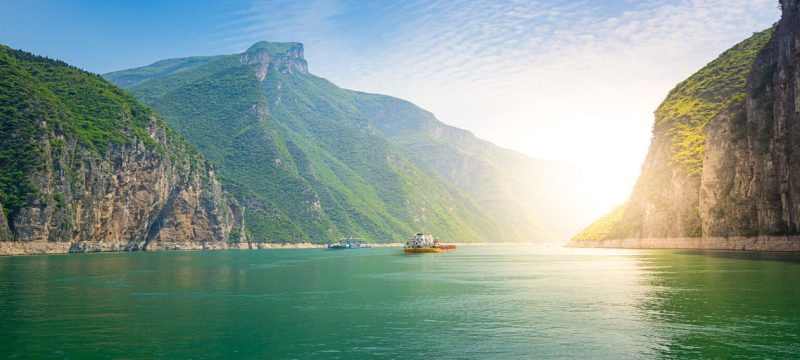Imagine a river that has shaped empires, powered cities, and still hides endangered creatures beneath its surface; that’s the Yangtze River. The Yangtze is more than water cutting across a map; it is the spine of modern China and a living archive of history, nature, and industry.
In this post, you’ll get a clear, reader-friendly tour of its key facts, why it matters today, and what’s at stake for the future.
Quick facts: the lifeline in numbers
The Yangtze River (also called the Chang Jiang) runs roughly 3,915 miles (about 6,300 km) from the Tibetan Plateau to the East China Sea, making it the longest river in Asia and the third-longest in the world. Encyclopedia Britannica
Those numbers matter because the river’s length and basin tie together mountains, farmland, megacities, and coastlines, all in one interconnected system.
Where it starts and where it goes
The Yangtze’s source is high on the Tibetan Plateau; it then cuts eastward through deep gorges and broad plains before emptying near Shanghai into the East China Sea. Along the way, it passes major cities such as Chongqing and Wuhan, and the river’s lower reaches form one of the world’s most productive economic regions: the Yangtze River Delta. Encyclopedia Britannica+1
Power, flood control, and a giant concrete answer
One of the most visible human footprints on the Yangtze River is the Three Gorges Dam. Completed in stages and fully operational by 2012, the dam is the world’s most productive hydroelectric facility with an installed capacity of about 22,500 megawatts. Its goals: generate power, reduce catastrophic flooding, and open inland waterways for larger ships. Yet the dam also sparked controversy over environmental impacts, resettlement of communities, and changes to sediment and ecosystems. Encyclopedia Britannica+1
Life on the river: people and economy
Billions of tons of cargo travel the Yangtze’s channels every year. The river is a commercial superhighway linking inland industry to coastal ports; the Yangtze River Economic Belt is central to China’s trade, agriculture, and urbanization plans. International organizations, including the World Bank, have supported basin projects aimed at balancing development with flood risk reduction and ecological protection. World Bank
Fragile wonders: the river’s wildlife
For all its size and power, the Yangtze is home to species found nowhere else, and some are in grave danger. The Yangtze finless porpoise, a freshwater cetacean, is now classified as critically endangered due to pollution, boat traffic, and habitat loss. Conservation groups and scientists are working on captive breeding, protected reserves, and stricter river management to try to restore populations. World Wildlife Fund
Why the Yangtze River matters globally
From climate resilience to global trade, the health of the Yangtze affects more than China. Floods or droughts in its basin threaten food and livelihoods; pollution or dam projects can shift sediment and biodiversity patterns that have downstream and regional consequences. Moreover, the river’s delta supports a massive population and some of the country’s largest ports, meaning local policies have global economic ripple effects. Encyclopedia BritannicaWorld Bank
Challenges ahead
- Pollution from industry and agriculture.
- Overfishing and shrinking habitats for native species.
- Balancing hydropower and ecological protection after mega-dam projects.
- Urban growth and the pressure it places on water quality and flood control.
Each of these challenges is solvable only with coordinated science-based policy, investment in a cleaner industry, and active conservation programs.
Small wins, big shifts
There are positive moves: river cleanup initiatives, protected zones for species like the finless porpoise, and international support for smart basin management. These show that the Yangtze’s future can be brighter if conservation and development are planned together.
FAQ
Q: How long is the Yangtze River?
A: About 3,915 miles (6,300 km) from the Tibetan Plateau to the East China Sea. Encyclopedia Britannica
Q: Is the Three Gorges Dam on the Yangtze?
A: Yes, it’s on the middle reaches of the river and is the world’s largest hydroelectric power station by installed capacity (~22,500 MW). Encyclopedia Britannica
Q: Are there endangered animals in the Yangtze?
A: Sadly, yes. The Yangtze finless porpoise is critically endangered; other native species also face threats from habitat change and pollution. World Wildlife Fund
Q: Can boats travel the whole Yangtze?
A: Large ships can navigate major stretches; the river is a vital inland shipping route connecting inland China to the sea. Encyclopedia Britannica
Q: What’s the biggest environmental issue on the river?
A: It’s a mix: pollution, habitat loss, and the impacts of large infrastructure projects. Solving any single problem requires a basin-wide approach. World BankEncyclopedia Britannica
Read More: Types Of Penguin: A Friendly Guide To 18 Penguin Species









